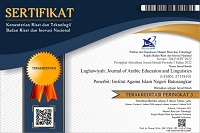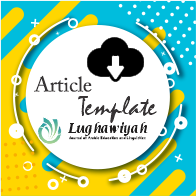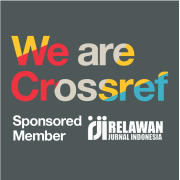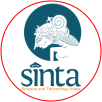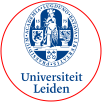THE UTILIZATION OF CANVA APPLICATION IN SUPPORTING EARLY CHILDHOOD ARABIC LANGUAGE LEARNING: TEACHERS' PERCEPTIONS / PEMANFAATAN APLIKASI CANVA DALAM MEDUKUNG PEMBELAJARAN BAHASA ARAB ANAK USIA DINI: PERSEPSI GURU
Abstract
The aim of this research is to describe teachers' perceptions on the use of Canva application in supporting early childhood Arabic language learning. The method employed was a quantitative descriptive approach. Data were collected through online questionnaire. 20 teachers were selected as respondents using purposive sampling. Data analysis was conducted using quantitative descriptive analysis. The findings of this research indicate that the utilization of the Canva application can support early childhood Arabic language learning. Canva can serve as an effective alternative to improving the quality of Arabic language education for young children. The use of this application can support early childhood Arabic language learning and assist teachers in creating engaging and easily comprehensible learning materials. It’s because of Arabic language learning for young children requires a creative and innovative approach to make it easier for children to understand and absorb the lesson materials. One solution to enhance the effectiveness of Arabic language learning is by using digital technology, such as the Canva application. In the future, there is potential for similar research on other areas of education.
Keywords
Full Text:
PDFReferences
Abiodun, O. I., Jantan, A., Omolara, A. E., Dada, K. V., Mohamed, N. A., & Arshad, H. (2018). State-of-the-art in artificial neural network applications: A survey. Heliyon, 4(11), e00938. https://doi.org/10.1016/j.heliyon.2018.e00938
Ahmad, N. A., & Yin, K. Y. (2019). Using interactive media to support reading skills among underachieving children. International Journal of Innovation, Creativity and Change, 8(7), 81–88.
Aisyah, N., Panjaitan, S., & Rasyid, H. Al. (2023). Pengembangan Media Pembelajaran Komik Bahasa Arab Berbasis Canva. Journal Of Education Research, 4(2), 484–495. https://doi.org/https://doi.org/10.37985/jer.v4i2.182
Akbar, Y. M., & Mufidah, N. (2022). Innovation in Arabic Speaking Learning During Pandemic: a Study at Man Pematangsiantar. Lughawiyah: Journal of Arabic, 4(1), 63–70. https://ojs.iainbatusangkar.ac.id/ojs/index.php/lughawiyah/article/view/5987
Allison, S. Z. (2023). Islamic Educational Provisions in South Korea and Indonesia : A Comparison. Journal of Islamic Education Students, 3, 50–61. https://doi.org/10.31958/jies.v3i1.8772
Azahra, O. S., & Widayanti, R. (2022). The Effect Of Sociodrama On Students’ Arabic Speaking Skill. Lughawiyah, 4(1), 1–10.
Aziz, A., Suhada, & Masruri, A. (2022). Aktivitas Pembelajaran Bahasa Arab Anak Usia Dini dengan Pendekatan Psikologi Humanistik Carl R. Rogers. El-Athfal : Jurnal Kajian Ilmu Pendidikan Anak, 2(02), 64–78. https://doi.org/10.56872/elathfal.v2i02.831
Bogart, K. R., & Dunn, D. S. (2019). Ableism Special Issue Introduction. Journal of Social Issues, 75(3), 650–664. https://doi.org/10.1111/josi.12354
Budiarti, E., Susanti, A., Elliza, E., Purwanti, E., Naif, M. M., Nureda, N., & Syarifah, R. U. (2016). Pemanfaatan Aplikasi Canva sebagai Video Pembelajaran untuk mengenalkan Konsep Bilangan Kelompok Usia 4-5 Tahun di TK Ceria Kabupaten Pasuruan. AKSARA: Jurnal Ilmu Pendidikan Nonformal, 09(September), 1–23. https://doi.org/http://dx.doi.org/10.37905/aksara.9.3.1821-1838.2023 Abstract
Devianti, R., Sari, S. L., & Bangsawan, I. (2020). Pendidikan Karakter untuk Anak Usia Dini. MITRA ASH-SHIBYAN: Jurnal Pendidikan Dan Konseling, 3(02), 67–78. https://doi.org/10.46963/mash.v3i02.150
Ecoffet, A., Huizinga, J., Lehman, J., Stanley, K. O., & Clune, J. (2021). First return, then explore. Nature, 590(7847), 580–586. https://doi.org/10.1038/s41586-020-03157-9
Elas, N. I. B., Majid, F. B. A., & Narasuman, S. A. (2019). Development of Technological Pedagogical Content Knowledge (TPACK) For English Teachers: The Validity and Reliability. International Journal of Emerging Technologies in Learning (IJET), 14(20), 18. https://doi.org/10.3991/ijet.v14i20.11456
Elsa, E., & Anwar, K. (2021). The Perception of Using Technology Canva Application as a Media for English Teacher Creating Media Virtual Teaching and English Learning in Loei Thailand. Journal of English Teaching, Literature, and Applied Linguistics, 5(1), 62. https://doi.org/10.30587/jetlal.v5i1.2253
Fadillah, F. U., Akib, T., & Musfira, M. (2023). Peningkatan Kemampuan Bahasa Dengan Menggunakan Media Pembelajaran Berbasis Aplikasi Canva di RA Aisyiyah Bontorita Kabupaten Takalar. KHIRANI: Jurnal Pendidikan Anak Usia Dini, 1(3). https://doi.org/https://doi.org/10.47861/khirani.v1i3.474
Fajri, Z., Dewi Riza, I. F., Azizah, H., Sofiana, Y., Ummami, U., & Andila, A. (2022). Pemanfaatan Media Pembelajaran Visual Berbasis Apilkasi Canva dalam Meningkatkan Minat dan Motivasi Belajar Anak Usia Dini di PAUD Al Muhaimin Bondowoso. Equilibrium: Jurnal Pendidikan, 10(3), 397–408. https://doi.org/10.26618/equilibrium.v10i3.8583
Fauziddin, M., & Fikriya, M. (2020). Mengenal Kosakata Bahasa Arab melalui Permainan Kartu Huruf Hijaiyah yang Dilengkapi Kosakata. Journal on Early Childhood Education Research (JOECHER), 1(2), 90–99. https://doi.org/10.37985/joecher.v1i2.13
Febriyenti, D., & Jamilus, J. (2024). Human Resource Management in Islamic Educational Institutions at Integrated Islamic Junior High Schools. Journal of Islamic Education Students, 3(2023), 62–71. https://doi.org/10.31958/jies.v3i1.9492
Fitria, T. N. (2022). Using Canva As Media for English Language Teaching (Elt) in Developing Creativity for Informatics Students’. ELT Echo : The Journal of English Language Teaching in Foreign Language Context, 7(1), 58. https://doi.org/10.24235/eltecho.v7i1.10789
Gonadi, L. (2017). The Development of Early Childhood E-Port In The Implementation Of Authentic Assessment In Early Childhood Institutions. 118, 547–552. https://doi.org/10.2991/icset-17.2017.90
Groccia, J. E. (2018). What Is Student Engagement? New Directions for Teaching and Learning, 2018(154), 11–20. https://doi.org/10.1002/tl.20287
Hadi, M. S., Izzah, L., & Paulia, Q. (2021). Teaching Writing Through Canva Application To Enhance Students’ Writing Performance. JOLLT Journal of Languages and Language Teaching, 9(2), 228. http://ojs.ikipmataram.ac.id/index.php/jollt/index
Hidayati, W. R., Warmansyah, J., & Zulhendri, Z. (2022). Upaya Penguatan Nilai-Nilai Karakter Islam Moderat pada Satuan Pendidikan Anak Usia Dini. Jurnal Obsesi : Jurnal Pendidikan Anak Usia Dini, 6(5), 4219–4227. https://doi.org/10.31004/obsesi.v6i5.1756
Hoesterey, J. B. (2020). Rebranding Islam. Stanford University Press. https://doi.org/10.1515/9780804796385
Ilham, S., Vázquez-cano, E., & Novita, L. (2022). Use of Canva Application as a Learning Media. Al-Hijr: Journal of Adulearn World, 1(1), 9–15.
Isbell, E., Calkins, S. D., Swingler, M. M., & Leerkes, E. M. (2018). Attentional fluctuations in preschoolers: Direct and indirect relations with task accuracy, academic readiness, and school performance. Journal of Experimental Child Psychology, 167, 388–403. https://doi.org/10.1016/j.jecp.2017.11.013
Ismandela, A., Nabila, D. F., Wulandari, R., Halif, A., Rusadi, P., Saputri, N., Putri, W., Warmansyah, J., Islam, P., & Usia, A. (2023). Strengthening Early Childhood Teacher Services In Creativity To Make Inspirational Educational Tools. 2(2), 191–200.
Jumami, M. F. (2021). Using Canva in Teaching Writing To Efl Classroom Students. Bogor English Student And Teacher (BEST) Conference, 3, 60–65.
Latif, G., Mohammad, N., Alghazo, J., AlKhalaf, R., & AlKhalaf, R. (2019). ArASL: Arabic Alphabets Sign Language Dataset. Data in Brief, 23, 103777. https://doi.org/10.1016/j.dib.2019.103777
Manurung, M. T., Okti Trihastuti Dyah Retnaningrum, & Sigit Sugiharto. (2022). Pelatihan Pembuatan Curriculum Vitae Menggunakan Aplikasi CANVA Bagi Mahasiswa Tingkat Akhir Universitas Widya Husada Semarang. JURPIKAT (Jurnal Pengabdian Kepada Masyarakat), 3(2), 400–412. https://doi.org/10.37339/jurpikat.v3i2.1013
Manzano, D. (2020). A short introduction to the Lindblad master equation. AIP Advances, 10(2). https://doi.org/10.1063/1.5115323
McCarthy, A. (2021). Staging joyful spectacles: Exploring the temporalities of positive affect in child-focused NGO programmes. Critique of Anthropology, 41(2), 111–127. https://doi.org/10.1177/0308275X211004723
McCarthy, J., & Wright, P. (2018). The Enchantments of Technology (pp. 359–373). https://doi.org/10.1007/978-3-319-68213-6_23
Melinia, S., & Nugroho, N. (2022). Creating a Video Using Canva Application as an English Learning Media of Recount Text Material. JEdu: Journal of English Education, 2(2), 118–129. https://doi.org/10.30998/jedu.v2i2.6644
Mualim, R., & Saputra, M. F. (2021). Optimizing Online Learning during Covid 19 Pandemic in Junior High School. Journal of Islamic Education Students (JIES), 1(1), 19. https://doi.org/10.31958/jies.v1i1.3193
Mudinillah, A., Amrina, A., & Hamid, M. A. (2022). The Utilization of the Canva Application as A Media for Arabic Learning at MTs Negeri Sungai Jambu. Acitya: Journal of Teaching and Education, 4(2), 406–422. https://doi.org/10.30650/ajte.v4i2.3192
Mudinillah, A., & Rizaldi, M. (2021). Using the Canva Application as an Arabic Learning Media at SMA Plus Panyabungan. At-Tasyrih: Jurnal Pendidikan Dan Hukum Islam, 7(2), 95–106. https://doi.org/10.55849/attasyrih.v7i2.67
Muliana, H., & Warmansyah, J. (2022). Pengembangan Media Pembelajaran Interaktif Speaking Pyramid untuk Meningkatkan Penguasaan Kosa Kata Bahasa Inggris Anak Usia 5-6 Tahun. Journal of Science and Technology, 2(1), 51–60.
Mulyanti, F., & Bayan, R. P. (2022). Improving The Child ’ s Moral Development through The Storytelling Method on Children 5 – 6 Years Old. Indonesian Journal of Early Childhood Educational Research, 1(2), 48–62. https://doi.org/10.31958/ijecer.v1i2.6923
Munawwarah, H., & Hibana, H. (2022). Implementasi Pengenalan Kosakata Bahasa Arab pada Anak Usia 5-6 Tahun. Jurnal Obsesi : Jurnal Pendidikan Anak Usia Dini, 6(6), 5454–5462. https://doi.org/10.31004/obsesi.v6i6.2989
Nahar, S., Suhendri, Zailani, & Hardivizon. (2022). Improving Students’ Collaboration Thinking Skill under the Implementation of the Quantum Teaching Model. International Journal of Instruction, 15(3), 451–464. https://doi.org/10.29333/iji.2022.15325a
Nastiti, F. E., & ‘Abdu, A. R. N. (2020). Kesiapan Pendidikan Indonesia Menghadapi era society 5.0. Edcomtech: Jurnal Kajian Teknologi Pendidikan, 5(1), 61–66.
Nisak, F. F., Munawaroh, H., & Abbas, S. (2022). The Effect of “ Kids Moderations ” Interactive Multimedia on Religious Moderation Attitudes in Early Childhood. Indonesian Journal of Early Childhood Education Research, 1(1), 38–47. https://doi.org/10.31958/ijecer.v1i1.5811
Nugroho, F., & Prambodo, Y. L. (2022). Pelatihan Penggunaan Copywriting bagi Komunitas Kubependa Rawalumbu Bekasi. Jurnal Pengabdian Masyarakat Gemilang (JPMG), 2(3), 62–68. https://www.journal.hdgi.org/index.php/jpmg/article/view/67
Nur, A., Rejekiningsih, T., Triyanto, T., & Rusnaini, R. (2020). Development of Interactive Multimedia Learning Courseware to Strengthen Students’ Character. European Journal of Educational Research, 9(3), 1267–1279. https://doi.org/10.12973/eu-jer.9.3.1267
Pujasari, R. S., & Ruslan, R. (2021). Utilizing Canvas in Technology Enhanced Language Learning Classroom: a Case Study. The Journal of English Literacy Education: The Teaching and Learning of English as a Foreign Language, 8(1), 42–54. https://doi.org/10.36706/jele.v8i1.14240
Rahayu, W. P., Zutiasari, I., & Munadhiroh, S. (2021). Learning Media of Canva Based on Flipbook in the Subjects of Creative Products and Entrepreneurship to Improve Students’ Digital Technopreneurship Competence. https://doi.org/10.2991/aebmr.k.210616.033
Rahmawati, P. A., Mandasari, V., Evanthy, A., & ... (2022). Pelatihan Canva Untuk Membranding Media Sosial Sanggar Kesenian Budaya. Literasi: Jurnal Pengabdian Masyarakat Dan Inovasi, 2(2), 1370–1375. https://jurnal.politap.ac.id/index.php/literasi/article/view/582
Ramadhan, R., & Ubudiyah, K. (2022). Motivation of Non-Madrasa Graduates in Studying Arabic at Department of Arabic Language Education, State Islamic Institute, Kendari. Lughawiyah, 4(2), 71–82.
Rosdiani, A., & Warmansyah, J. (2021). Perancangan Game Edukasi Berhitung Berbasis Mobile Aplikasi Inventor. Journal of Science and Technology, 1(2), 198–206.
Safutri, J. T., Febriani, S. R., & Hilmi, D. (2020). Improvement of Arabic Language Teacher Competency Based on Multiple Intelligence Classroom. Lughawiyah: Journal of Arabic Education and Linguistics, 2(1). https://doi.org/10.31958/lughawiyah.v2i1.1949
Salam, M. Y., & Adam Mudinillah. (2021). Canva Application Development for Distance Learning on Arabic Language Learning in MTs Thawalib Tanjung Limau Tanah Datar. JTP - Jurnal Teknologi Pendidikan, 23(2), 101–111. https://doi.org/10.21009/jtp.v23i2.20650
Setyorini, S., Agustino, H., Hidayatullah, S., & Rachmawati, I. K. (2022). Pelatihan Komputer Desain Canva Bagi Anak Remaja Di Desa Mojosari Kepanjen Malang. Jurnal Pengabdian Kepada Masyarakat, 02(01), 793–798.
Suri, D., & Chandra, D. (2021). Teacher’s strategy for implementing multiculturalism education based on local cultural values and character building for early childhood education. Journal of Ethnic and Cultural Studies, 8(4), 271–285. https://doi.org/10.29333/ejecs/937
Ubaidillah, U., Muflih, M., Fajri, N., Jaili, H., & Azimah, N. (2023). The Importance of Digital Media in Arabic Language Learning; The Use of Canva in Vocabulary Learning. Jurnal Al-Maqayis, 10(1), 36. https://doi.org/10.18592/jams.v10i1.8675
Ulum, M., & Mun’im, A. (2023). Writing Assistance Through Canva Application for Class IX Students of SMP Mambaul Ihsan Gresik. Jurnal Penelitian Dan Pengabdian Masyarakat, 1(1), 10–19. https://doi.org/10.61231/jp2m.v1i1.34
Umam, N., & Budiyati, U. (2020). Pembelajaran Bahasa Arab Anak Usia Dini Berbasis NIlai-Nilai Karakter. Jurnal Warna, 4(1), 46–64.
Usmiyatun, Sah, R. A., & Darmayanti, R. (2023). Design Development of Audiovisual Teaching Materials for Canva Application-based Reading Skills in Early Childhood. Jurnal Caksana: Pendidikan Anak Usia Dini, 4(1), 1–12.
Vygotsky, L. S. (2021). Early Childhood (pp. 153–187). https://doi.org/10.1007/978-981-16-1907-6_8
Wahyuni, S. I., Dewi, A. C., Diniyyah, S., Rahmah, P., Yunusiyyah, E., & Panjang, P. (2023). Improving Literacy Skills through Letter Ball Games for Children 5-6 Years Old Pendidikan Pra sekolah atau yang dikenal dengan Pendidikan Anak Usia Dini melatih anak dalam membaca ( Bahrun et al ., 2020 ). Setelah anak siap untuk membaca. Indonesian Journal of Early Childhood Educational Research, 1(2), 63–74. https://doi.org/10.31958/ijecer.v1i2.8213
Warmansyah, J., Komalasari, E., Febriani, E., Gusmiati, & Amalina. (2022). Factors Affecting Teacher Readiness for Online Learning (TROL) in Early Childhood Education: TISE and TPACK. Jurnal Pendidikan Usia Dini, 16(1), 32–51. https://doi.org/https://doi.org/10.21009/JPUD.161.03
Warmansyah, J., Komalasari, E., Yuningsih, R., Sari, M., Rahmadani, W., Putri, H., Mulia, ), Data, R., Yanti, E. P., Anak, P. I., & Dini, U. (2022). Pelatihan Canva for Education Untuk Guru Paud Se Kabupaten Tanah Datar Canva for Education Training for Early Children Education Teachers Tanah Datar Districk 1). 3(2). https://ejournal.unib.ac.id/index.php/abdipaud/index
Widayanti, L., Kala’lembang, A., Adhariyanty Rahayu, W., Yulia Riska, S., & Arya Sapoetra, Y. (2021). Edukasi Pembuatan Desain Grafis Menarik Menggunakan Aplikasi Canva. Jurnal Pengabdian Masyarakat, 2(2), 91–102. https://doi.org/10.32815/jpm.v2i2.813
Wulandani, C., Afina Putri, M., Indah Pratiwi, R., & Sulong, K. (2022). Implementing Project-Based Steam Instructional Approach in Early Childhood Education in 5.0 Industrial Revolution Era. Indonesian Journal of Early Childhood Educational Research (IJECER), 1(1), 29–37. https://doi.org/10.31958/ijecer.v1i1.5819
Wulandari, T., & Mudinillah, A. (2022). Efektivitas Penggunaan Aplikasi CANVA sebagai Media Pembelajaran IPA MI/SD. Jurnal Riset Madrasah Ibtidaiyah (JURMIA), 2(1), 102–118. https://doi.org/10.32665/jurmia.v2i1.245
Yadav, S., Chakraborty, P., & Mittal, P. (2022). Designing Drawing Apps for Children: Artistic and Technological Factors. International Journal of Human–Computer Interaction, 38(2), 103–117. https://doi.org/10.1080/10447318.2021.1926113
Zhang, C., Yao, C., Wu, J., Lin, W., Liu, L., Yan, G., & Ying, F. (2022). Story Drawer: A Child–AI Collaborative Drawing System to Support Children’s Creative Visual Storytelling. CHI Conference on Human Factors in Computing Systems, 1–15. https://doi.org/10.1145/3491102.3501914
Zhou, N., & Yadav, A. (2017). Effects of multimedia story reading and questioning on preschoolers’ vocabulary learning, story comprehension and reading engagement. Educational Technology Research and Development. https://doi.org/10.1007/s11423-017-9533-2
DOI: http://dx.doi.org/10.31958/lughawiyah.v5i2.10781
Refbacks
- There are currently no refbacks.

This work is licensed under a Creative Commons Attribution-NonCommercial 4.0 International License.
Lughawiyah Indexed By:

Lughawiyah distribute under Lisensi Creative Commons Atribusi-NonKomersial 4.0 Internasional.
View My Stats lughawiyah
